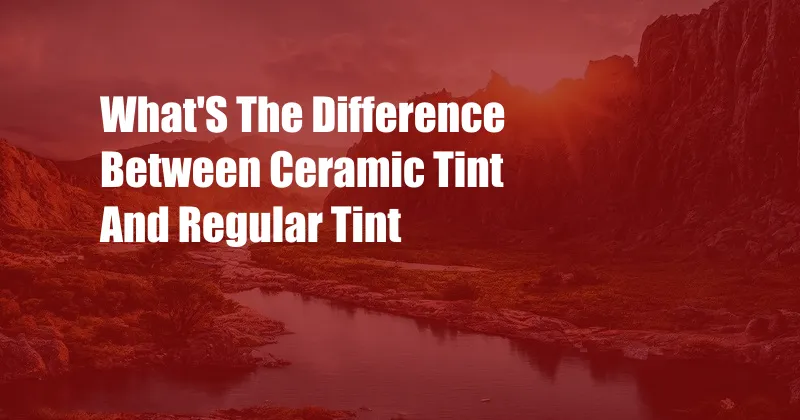
Ceramic Tint vs. Regular Tint: Unlocking the Ultimate Guide
Picture this: you’re cruising along the highway, the summer sun blazing through your windows. The heat is unbearable, and the glare makes it challenging to see. You crave a solution that offers both comfort and protection. Enter window tinting, a savior against the harsh elements. But wait, there’s a wrinkle in the tapestry – ceramic tint vs. regular tint. What’s the difference, and which one should you choose for your automotive sanctuary?
Prepare to embark on a journey into the realm of window tinting, where we’ll dissect the intricacies of ceramic tint and regular tint, equipping you with the knowledge to make an informed decision for your vehicle.
Ceramic Tint: The Pinnacle of Window Tinting Technology
Imagine a window tint that transcends the ordinary, offering unparalleled clarity and UV protection. Ceramic tint is the answer, crafted from a cutting-edge blend of ceramic particles and metallic oxides. This fusion of materials grants ceramic tint its superior performance, earning it the title of “the gold standard” in the window tinting industry.
Ceramic tint’s prowess lies in its ability to block up to 99% of harmful UV rays, safeguarding your skin and vehicle’s interior from sun damage. Moreover, its non-metallic composition eliminates radio interference, ensuring seamless connectivity for your favorite radio stations and mobile devices. The cherry on top is its unmatched heat rejection capabilities, keeping your car’s interior cool and comfortable even on the most sweltering summer days.
Regular Tint: A Cost-Effective Window Tinting Option
While ceramic tint reigns supreme in the realm of window tinting, regular tint stands as a more economical alternative. Crafted from a blend of metal and polyester, regular tint offers a decent level of UV protection and glare reduction.
However, regular tint falls short in terms of heat rejection compared to its ceramic counterpart. Additionally, its metallic composition may interfere with radio signals, potentially disrupting your driving experience. Despite these shortcomings, regular tint remains a viable choice for those seeking a cost-effective window tinting solution.
Ceramic Tint vs. Regular Tint: A Comparative Overview
To further illuminate the distinctions between ceramic tint and regular tint, let’s delve into a comparative overview:
- UV Protection: Ceramic tint takes the lead, blocking up to 99% of UV rays, while regular tint offers moderate UV protection.
- Heat Rejection: Ceramic tint outperforms regular tint in heat rejection, providing superior comfort and energy efficiency.
- Glare Reduction: Both ceramic tint and regular tint effectively reduce glare, enhancing visibility and driving safety.
- Radio Interference: Ceramic tint’s non-metallic composition eliminates radio interference, while regular tint may cause disruptions.
- Durability: Over time, ceramic tint retains its performance and appearance better than regular tint.
- Cost: Regular tint is generally more cost-effective than ceramic tint.
Choosing the Right Tint for Your Vehicle
The choice between ceramic tint and regular tint hinges upon your priorities and budget. If you seek the highest level of UV protection, heat rejection, and durability, ceramic tint is the clear winner. Yet, if cost is your primary concern, regular tint may suffice.
Expert Tips for Window Tinting
To ensure a successful window tinting experience, heed these expert tips:
- Research local tinting laws: Tinting regulations vary by state, so it’s crucial to check local laws to avoid legal issues.
- Choose a reputable installer: A skilled and experienced installer will ensure a flawless installation and optimal performance.
- Consider the tint percentage: Select a tint percentage that provides the desired level of privacy and visibility.
- Protect your tint: Avoid rolling down tinted windows for a few days after installation to allow the tint to fully adhere.
- Maintain your tint: Wash your tinted windows regularly with a mild soap and water solution to preserve their appearance.
Frequently Asked Questions on Ceramic Tint and Regular Tint
Q: Is ceramic tint worth the extra cost?
A: If you prioritize superior UV protection, heat rejection, and durability, ceramic tint is a worthwhile investment.
Q: Can ceramic tint interfere with dashcams or GPS devices?
A: High-quality ceramic tint will not interfere with these devices.
Q: What is the legal tint percentage for my state?
A: Laws vary by state, so it’s best to check with your local DMV or visit the International Window Film Association (IWFA) website for details.
Q: Can I remove window tint myself?
A: While it’s possible to attempt DIY tint removal, it’s highly recommended to seek professional assistance to avoid damaging your windows.
Conclusion
The choice between ceramic tint and regular tint is a matter of personal preference, budget, and desired performance. If you’re seeking the ultimate in window tinting protection, comfort, and longevity, ceramic tint is the unparalleled choice. However, if budget is a primary concern, regular tint remains a viable option.
Remember, a well-tinted vehicle not only enhances your driving experience but also adds a touch of style and sophistication to your ride. Are you ready to embark on the journey to a more comfortable and protected driving experience? Consult with reputable window tinting professionals and discover the world of ceramic tint and regular tint today.